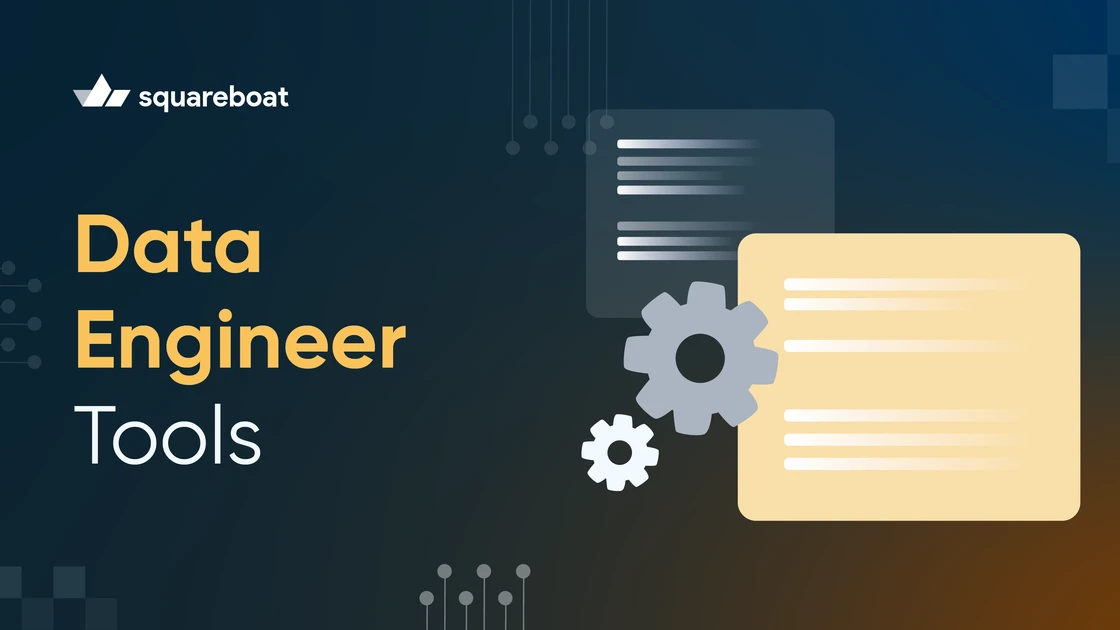In the digital gold rush, everyone wants insights. These insights don’t appear out of thin air; they arrive on tracks laid by data engineers with the right tools. Apache Kafka, Airflow, Redshift, Snowflake, and many more, these data engineering tools make the data your insights. They help businesses collect, organize, store, and understand data, making them essential for any company that wants to use data to grow and make smarter decisions.
What is Data Engineering?
Data engineering is the technical backbone of data-driven organizations. It is the process of developing and organising systems that collect, store, and analyse data at scale. Data engineering involves:
- Data ingestion
- Data storage
- Data processing
- Data orchestration
- Data quality and governance
Data engineers are the masterminds behind robust data pipelines that automate the journey of data from various sources to storage solutions and analytical platforms. These professionals automate the extraction, transformation, and loading (ETL) procedures using a variety of data engineering tools, guaranteeing that the data is reliable, consistent, and easily accessible for analysis. The ultimate goal is to make data accessible and useful for data scientists, analysts, and business stakeholders.
Top Data Engineering Tools
Curious about which tools data engineers rely on to tackle big data challenges? This blog has got you covered! We’ve compiled a list of the 15 most popular and powerful data engineering tools of 2026.
Apache Spark
Apache Spark is a powerful open-source engine for large-scale data processing. It handles both batch and real-time streams, enabling fast, distributed computations. It supports SQL, ML, and graph processing. It’s fault-tolerant, scalable, and perfect for data engineering.
Features:
- Multi-language support
- Robust fault tolerance
- In-memory engine
Apache Kafka
Built for speed and scalability, Apache Kafka is a go-to tool for data engineers who need to build robust, real-time data pipelines. It simplifies the movement and processing of data streams at scale. Its publish-subscribe model allows communication between data producers and consumers, facilitating dynamic data workflow.
Features:
- Real-time stream processing
- Publish-subscribe model
- Distributed architecture
- Fault tolerance
dbt (data build tool)
dbt is a modern data engineering tool that focuses on the “T” in ETL (Extract, Transform, Load)– transforming data. It simplifies the process of structuring and validating data. It primarily operates as a command-line application. Users interact with dbt by writing SQL models and running commands in their terminal.
Features:
- Version control
- Modular SQL
- Auto documentation
PostgreSQL
PostgreSQL’s open architecture supports integration with various ETL and orchestration tools. It supports complex data transformations, indexing, and advanced querying. Its strong ACID compliance and support make it a reliable choice for a fault-tolerant data-engineering workflow.
Features:
- ACID compliant
- Open architecture
- Stored procedure
Snowflake
Snowflake is a cloud-based data platform offering a fully managed environment to process and analyze large volumes of data with ease. It supports both structured and semi-structured data, like JSON and Parquet, making it ideal for modern data pipelines. Its time travel and data cloning capabilities enhance data recovery and development efficiency.
Features:
- Time travel for data recovery
- Cloud-native
- Separate compute and storage
- Supports structured and semi-structured data
Airbyte
Airbyte is a modern, open-source data integration tool designed with simplicity and extensibility. It covers popular data sources like APIs, databases, and SaaS platforms. Its powerful connectors and replication mechanisms simplify the ETL process by automating data extraction and syncing.
Features:
- Open-source and extensible
- 200+ pre-built connectors
- Cloud and on-prem deployment support
BigQuery
BigQuery is a Google Cloud fully managed serverless data warehouse. Its distributed architecture and seamless integration with Google Cloud services makes it a preferred platform for building modern data pipelines.
Features:
- Automatic scaling
- Google Cloud integration
- Cost-efficient pay-as-you-go model
- Easy integration
Amazon Redshift
It is a cloud-based data warehouse from AWS, that provides data engineers with a fully managed platform to analyze all your data from multiple sources. Whether you're managing terabytes or petabytes of data, Redshift delivers fast and reliable performance.
Features:
- Fully managed by AWS
- Massively parallel processing (MPP)
- Automated backups & snapshots
Prefect
Prefect is a tool for orchestrating workflows that is open-source, designed specifically for contemporary data workflows and ETL (extract, transform, load) processes. It allows data engineers to define workflows as Python code, offering flexibility, observability, and fault tolerance.
Features:
- API-first design
- Auto-retries & error handling
- Python-native workflows
Power BI
As part of the Microsoft ecosystem, Power BI is a powerful business intelligence tool that helps teams visualize, analyze, and share data insights through interactive dashboards and reports.
Ideal for data engineers and analysts alike, it can turn raw data into clear, actionable visualizations using an intuitive drag-and-drop interface.
Features:
- Interactive dashboards
- Built-in AI visuals
- Seamless Microsoft integration
- Drag-and-drop interface
Metabase
Metabase, like Power BI, turns raw data into visual dashboards and charts—perfect for teams who want insights without writing SQL. It allows users to explore data by asking simple questions and supports both non-technical users through no-code queries and data experts through an advanced SQL editor, making it a perfect tool for all skill levels.
Features:
- No SQL needed for queries
- Customizable visuals
- Easy data exploration
Tableau
Tableau is a leading data visualization and business intelligence platform. It offers more advanced and highly customizable visualizations for complex data analysis. It provides deeper analytics and more flexible deployment.
Features:
- Deep visual storytelling
- Advanced visualizations
- Real-time dashboards
Dagster
It is a modern data orchestration platform designed to help data teams build, schedule, and monitor reliable data pipelines easily. It integrates seamlessly with popular data tools, ensuring data workflows are reliable, testable, and easy to manage.
Features:
- Easy pipeline orchestration
- Real-time monitoring
Apache Hadoop
Apache Hadoop is a powerful open-source platform for big data engineering. It allows data engineers to distribute and analyze massive datasets using its HDFS storage and MapReduce processing framework. It supports the end-to-end data engineering lifecycle.
Features:
- Distributed storage (HDFS)
- Batch processing (MapReduce)
- Fault-tolerant design
- Supports varied data types
Apache Nifi
Apache NiFi is a powerful open-source data integration tool that provides reliable, fault-tolerant data ingestion and routing. It uses a visual flow-based programming model using graphs consisting of processors and connections. This allows flexible and dynamic routing of data.
Features:
- Visual flow graph
- Easy drag-and-drop design
- Flow prioritization
Essential Factors to Consider When Selecting Data Engineering Tools
With so many choices of data engineering tools, it's hard to know which to pick. This guide shows you how to pick tools that make your data work easier and better.
- Ease of use: No one wants to waste hours learning how to use a tool. A good data engineering tool should offer intuitive UIs, clear workflows, and guided setups for better usage and efficiency.
- Scalability: As your data grows, your tools must scale without degrading performance. It's important to have the ability to easily link up with your existing data systems to avoid disruptions and maintain efficiency.
- Integration Capabilities: No tool operates in isolation. It should seamlessly integrate with your existing data infrastructure, which consists of databases, cloud computing, and business intelligence tools.
- Automation Support: In the world of data pipelines, manual execution is a bottleneck. Tools with built-in support for triggers, alerts, and automatic reruns help detect issues before they become problems, resulting in enhanced efficiency.
- Real-Time Processing: Customer expectations are real-time—your data tools should be too. It allows businesses to automate decisions and unlock continuous intelligence.
- Strong Community & Documentation: Even the most powerful tools are useless if no one knows how to use them. Whether it's Stack Overflow threads, GitHub issues, or Slack channels, a strong community presence ensures you’re never stuck for long and always learning new ways to optimize.
- Security & Compliance: Choosing tools with built-in compliance frameworks can help ensure your pipeline runs smoothly and adheres to strict legal requirements.
- Cost-Effectiveness: Evaluating cost effectiveness means looking past sticker prices. Look for platforms with predictable pricing that scale with your needs, so unexpected expenses can be avoided.
- Data Governance & Security: It is essential to ensure that the tool conforms to relevant regulations (such as GDPR and HIPAA) and meets industry standards for data security.
- Version Control and Collaboration: Managing complex data pipelines requires transparent versioning and teamwork. It helps engineers to experiment confidently and track progress.
Support for Multiple Data Formats: Data comes in many shapes and sizes. Tools that natively support every data format, be it CSV, SQL, JSON, or raw text, provide an advantage.
Conclusion
As data continues to shape the future of business, completely unlocking the value of their data, they need reliable data engineering tools. The right tools facilitate better data collection, processing, and analysis. Better systems enable businesses to make more informed decisions that promote stronger team decision-making, increase productivity, and spur growth.
In this blog, we’ve explored a range of top data engineering tools to help you stay informed, agile, and let the right data engineering tools unlock the full potential of your data.


